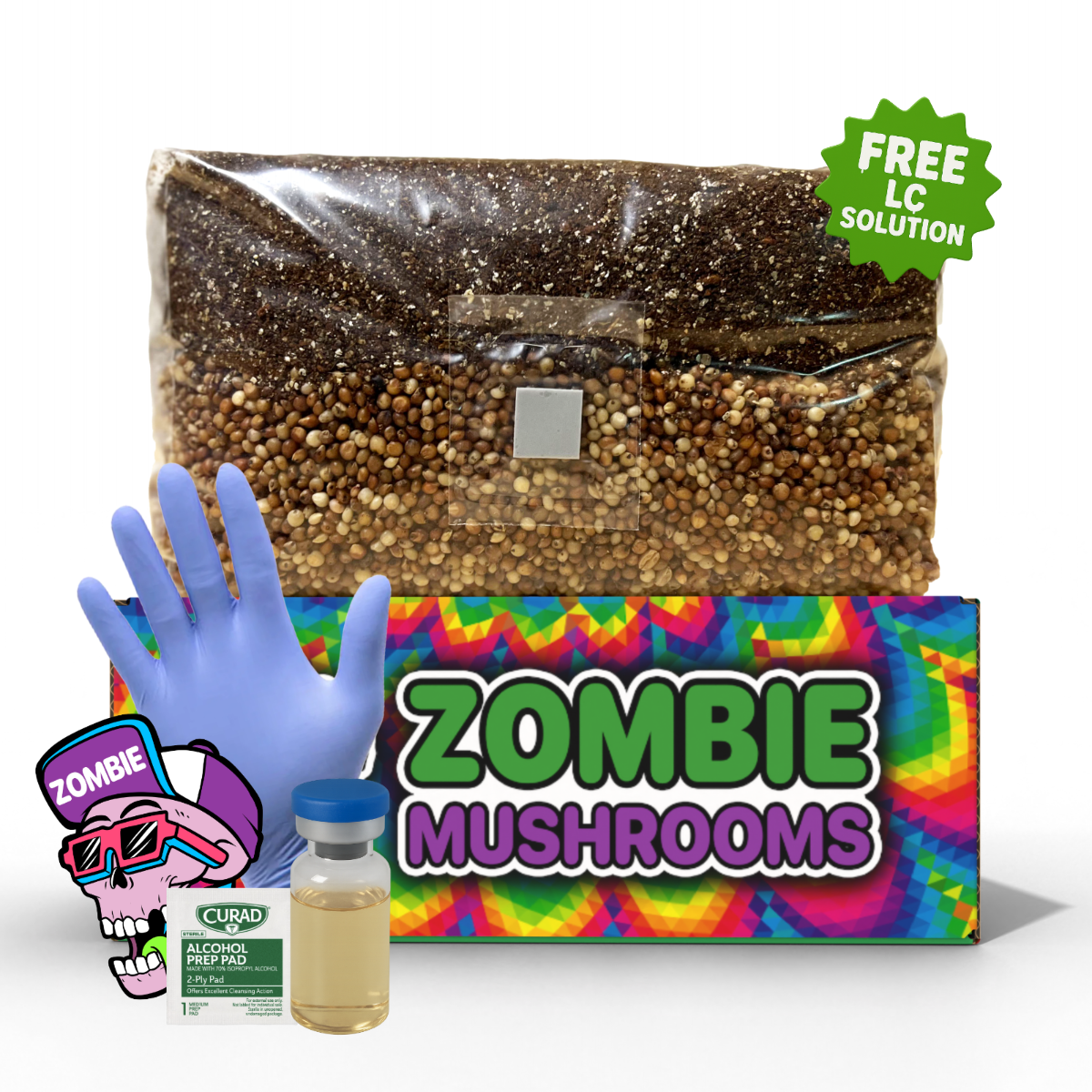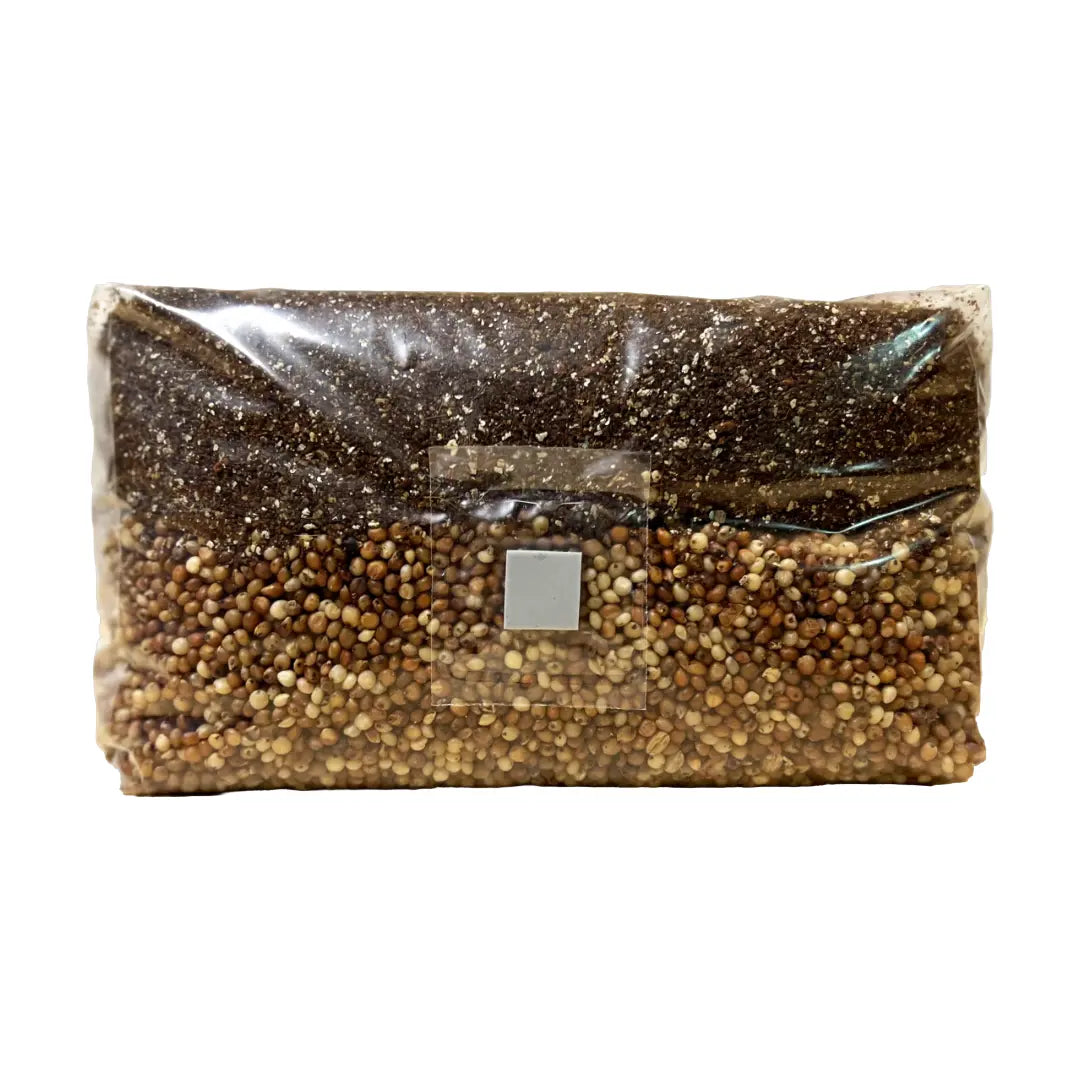⬇️ Prefer to listen instead? ⬇️

- Grain spawn helps things colonize faster and gives bigger yields compared to other spawn types.
- Storing grain spawn the wrong way means more risk of contamination and fewer mushrooms.
- Keeping things sterile when you add the spawn is key for growing mushrooms well.
- You can keep grain spawn at 33–38°F for up to 2 months if you store it right.
- Mixing 1 part grain spawn to 5 parts substrate material works best for good colonization and fruiting.
If you've been using mushroom grow kits and want larger yields—or want to try growing lesser-known or specialty types—mushroom grain spawn may be your next step. Grain spawn gives you more control, faster colonization, and broader species flexibility. If you'd rather avoid all the prep, our grain spawn bags offer a clean, ready-to-use solution that integrates easily into your grow setup. In this article, you'll learn what grain spawn is, when it’s worth using, how to store it properly, and how to mix it into substrates for strong harvests.

What Mushroom Grain Spawn Is & Why It’s Powerful
Grain spawn is sterilized cereal grain (such as rye, wheat, or millet) fully colonized by healthy mushroom mycelium. It serves as an intermediate stage between initial culture (like agar or liquid culture) and your bulk substrate. Key benefits:
-
It speeds up colonization because the mycelium is already active.
-
It works with many mushroom species and is particularly useful for indoor setups, monotubs, or grow bags where control and consistency matter.
-
The choice of grain impacts how well the mycelium spreads—for example, mildew-free organic rye holds water and nutrients well, while smaller grains like millet allow quicker spread.
Because it works well and has a lot of food in it, mushroom grain spawn is often used for growing mushrooms on a large scale, and for home projects that are a bit more advanced.

What Is Mushroom Grain Spawn Made Of?
Mushroom grain spawn is mostly made from whole cereal grains packed with food. The grains often used are
- Rye Berries – These have lots of food like magnesium and phosphorus that feed mycelium. Rye also holds water well without getting too sticky.
- Millet – It has a large surface area because the grains are small. This helps the mycelium spread quickly and evenly. Growers often like millet for mushroom types that grow fast.
- Wheat Berries – This is a balanced grain with good food content and a steady texture. Wheat is usually cheaper and easy to find.
- Sorghum and Corn – People use these for certain mushroom types. Corn grains are bigger and can get bacterial contamination easier. But they can support specific strains well.
Before adding mushroom cultures, these grains get soaked in water to get them wet. Then they are boiled to make the outside soft. After that, they are dried and heated very hot to kill any competing bacteria, molds, or yeasts.
How much water is in the grain and how you prepare it is very important. If the grain is too wet, it can create places without air, which lets contamination grow. But if it's not wet enough, the mycelium won't spread well, and colonization will be slow.
Grain Spawn vs. Other Mushroom Spawn Types
Knowing about the different kinds of spawn helps you pick the best one for what you want to grow. Here's how mushroom grain spawn compares to other spawn materials:
| Spawn Type | Best For | Pros | Cons |
|---|---|---|---|
| Grain Spawn | Intermediate to expert growers | Rapid colonization, adaptable to many species, ideal for indoor grows | Requires sterile handling, short shelf life |
| Sawdust Spawn | Outdoor projects, log cultivation | Cheaper than grain, easier to scale outdoors | Slower colonization, species limits |
| Plug Spawn | Long-term outdoor fruiting (logs/stumps) | Easy for beginners, low maintenance | Months or even years for fruiting |
| Mushroom Grow Kits | Absolute beginners | Zero setup time, includes all needed components | Limited yield, fewer species options |
Grain spawn mushrooms are great for people who want control over every step of growing. It's fast and efficient. This often makes it the go-to spawn for growing inside using methods like monotubs, grow bags, and Martha tents.

Who Should Use Grain Spawn Mushrooms?
Grain spawn is a good choice for growers who have some experience already and want bigger yields, more varieties, and to be more involved in growing mushrooms. Think about using grain spawn if you are
- Moving on from grow kits and want to try more advanced methods.
- Growing gourmet or medicinal mushrooms you can't find in store kits (like Lion’s Mane, Reishi).
- Wanting to try making your own substrates for specific mushroom types.
- Setting up a special grow area, like a tent, clean room, or a clean spot to work.
- Increasing how much you grow for yourself, a small farm, or selling locally.
You need to use sterile methods and have some know-how, so grain spawn isn't usually for someone just starting. But it's perfect for those ready to get more serious about growing.

Understanding Colonization: How Grain Spawn Works
After you add a viable culture (from agar or liquid) to mushroom grain spawn, the mycelium starts to spread through the grains. Here's how colonization usually happens
- Days 1–4 – You start seeing mycelium grow where you first added it.
- Days 5–10 – The mycelium spreads fast through the individual grains.
- Days 10–14 – It's fully colonized. The grains are completely covered in thick, white mycelium.
Once the grain spawn is fully colonized, you use it to put mycelium into a bigger amount of bulk substrate. When you mix it into materials like coir, straw, or hardwood sawdust, it makes hundreds of tiny spots where the mycelium can start growing out from. This helps the mycelium colonize the whole substrate well.
Signs It's Fully Colonized
- The whole bag or jar looks white, with no bare grains.
- You see thick clumps of mycelium.
- There are no signs of contamination, like strange colors (green, black, or pink), liquid pooling, or a bad smell.
If you see any of these signs of contamination, it's best not to use that batch.
Best Practices for Grain Spawn Storage & Usage
Grain spawn is living material. It needs the right storage conditions to stay healthy. You should keep it in a cool place. Ideally
-
Temperature: Store spawn in the refrigerator at around 33-38°F (0.5-3°C) to slow metabolic activity and prolong shelf life.
-
Packaging & Labeling: Use airtight, opaque bags or containers. Label with strain and date so you know which batches to use first.
-
Ideal Use Period: Though it can last up to 2 months if stored well, performance is best when used within 4 weeks. Older spawn may show slower colonization or increased risk of contamination.
-
Usage Ratios: For mixing, a standard ratio is 1 part grain spawn to 5 parts bulk substrate by weight. If speed is a priority, a 1:3 ratio gives faster colonization—but increases spawn cost.
-
Prepare Before You Order: Ensure your substrate is ready before spawn arrives. Best results come from using grain spawn promptly rather than letting it sit.
Signs that your grain spawn is spoiled
- A sour smell or one like ammonia – This often means bacterial contamination.
- Grains that are slimy or sticky – This shows too much water or fermentation.
- Changes in color – Yellow, green, or black colors mean contamination.
The Right Time: When to Order and Use Grain Spawn
Grain spawn starts to lose its strength after it hits peak colonization. To get the most out of it
- Get your fruiting substrate ready BEFORE your spawn arrives.
- Order spawn only when you are ready to mix it into the substrate in the next 7–10 days.
- Mix it into your substrate within a week of getting the spawn.
Keeping to this short timeline helps avoid weak colonization and lowers the chances of contamination, especially when growing in bulk. Good planning is important. Don't wait to mix the spawn once it shows up.

How to Use Grain Spawn for More Growth
Using mushroom grain spawn means mixing it into a substrate. Then it can grow bigger and later start fruiting. Common substrates include
- Pasteurized straw – Very good for mushroom types that grow fast, like oyster mushrooms.
- Coco coir and vermiculite (CV mix) – Popular for growing in monotubs, especially for types that need basic humidity.
- Hardwood sawdust – Best for Lion’s Mane, Shiitake, and Reishi mushrooms.
- Substrates with manure in them – Good for Agaricus and Psilocybe types (check legal rules).
Tips for Mixing
- Use a ratio of 1 part spawn to 5 parts substrate or 1 part spawn to 3 parts substrate by weight for the best results.
- Mix spawn and substrate in layers instead of all at once. This helps spread the mycelium more evenly.
- Keep things clean: clean surfaces, wear gloves, and don't create dusty or wet areas that could bring in contaminants.

Good Mushroom Types for Grain Spawn
Some mushroom types do really well when you use grain spawn
- Oyster Mushrooms (Pleurotus ostreatus) – Grow fast and work well on many kinds of substrate.
- Lion’s Mane (Hericium erinaceus) – Great for hardwood mixes and growing inside in fruiting chambers.
- Shiitake (Lentinula edodes) – Grows well in hardwood sawdust. It takes a bit longer but gives good results.
- Reishi (Ganoderma lucidum) – This is a medicinal mushroom. It likes growing for a long time on hardwood materials.
- Chestnut, Enoki, and Pioppino – These are not as well-known but are easy to grow with grain and sawdust mixes.
Trusted suppliers like Zombie Mushrooms usually sell these types either as ready-to-use grain spawn or as liquid cultures so you can add them yourself.
Sterility and Clean Technique: Do You Really Need It?
Keeping things sterile isn't just a nice idea—you really need it.
Unlike growing plants outside, growing mushrooms involves dealing with tiny competitors like bacteria and molds. Grain spawn has lots of water and food. This makes it an easy target for contaminants if you don't handle it right.
Main sterile practices
- Use a still air box (SAB) or laminar flow hood when you add the culture.
- Heat up needles, scalpels, and tools with a flame before using them.
- Work in an area with little movement and not much airflow. This stops spores in the air from getting into your workspace.
Once you mix the spawn into its pasteurized or sterilized substrate, being sterile is less critical. But keeping things clean is still important. Keeping bins closed, hands clean, and tools cleaned can help stop failures.
Things People Often Do Wrong with Mushroom Grain Spawn
- Mixing into substrate too soon – Wait until the grain spawn is fully colonized before trying to fruit or mixing it.
- Storing it wrong – Spoiled spawn won't grow. Always put it in the fridge with care.
- Mixing too much or too little – If you don't mix well, colonization will be slow or you'll get contamination.
- Using the wrong spawn ratios – Too much or too little grain spawn can mess up how it colonizes.
- Not sterilizing well first – Using grain that wasn't washed or is wet lets mold grow fast.
Don't take shortcuts. Being consistent and clean always gives you better yields.

How Much Grain Spawn Do You Need?
How much grain spawn you need depends on how big you want to grow and what you want to achieve
- 3 lbs of grain spawn = enough to inoculate about 10–15 lbs of substrate.
- 5–10 lbs of spawn = good for grow tents inside or multiple monotubs.
- Using more than the 1:5 ratio can make colonization faster, but it might cost more without a big enough payoff.
Use spawn calculators or ask your supplier for advice to plan your project reliably.

Why DIY Growers Like Grain Spawn
Here's why mushroom growers who like doing things themselves love using mushroom grain spawn
- Bigger yields for the money compared to grow kits.
- It grows fast, letting you expand it to many substrates.
- You get access to more strains and types, including gourmet and medicinal ones.
- You learn a lot, helping you get better at sterilization, working with cultures, and caring for specific mushroom types.
For home growers who are motivated, grain spawn gives you control and output that kits just can't match.

FAQ Section
-
What is the ideal ratio of grain spawn to substrate?
A good rule of thumb is about 1:5 by weight (spawn : substrate) for balanced colonization. Use 1:3 if you want faster colonization, keeping in mind costs. -
How long can grain spawn be stored before it loses effectiveness?
Stored at fridge temps (33-38°F), it can remain viable for up to 2 months, though performance tends to decline after the first 4 weeks. -
Which mushroom species grow best using grain spawn?
Fast growers like oyster mushrooms, lion’s mane, shiitake, and reishi often perform well with grain spawn. -
What are common mistakes when using grain spawn?
– Using spawn that isn’t fully colonized. <br>– Storage at too warm or fluctuating temperatures. <br>– Incorrect moisture content (too wet or too dry). <br>– Poor sterile technique during inoculation or mixing. -
When are mushroom grow kits a better choice than grain spawn?
For those just starting out, with limited space or fewer tools, grow kits provide a simpler, less risky entry point with less prep and sterile handling required.
When to Use Mushroom Grow Kits Instead
Not everyone needs grain spawn. Sometimes a ready-to-use grow kit is better
- For people growing for the first time who want an easy start.
- For people with not much space or who can't keep things sterile easily.
- For giving mushrooms as a gift or teaching kids.
- For trying a new type before doing bigger projects.
Mushroom grow kits often come with substrate that already has mycelium growing on it. You just need to mist it and give it indirect light before mushrooms grow. Zombie Mushrooms sells both, so you can pick what works for your growing stage.
Should You Pick Mushroom Grain Spawn?
Mushroom grain spawn is the most interesting and rewarding part of growing mushrooms for hobbyists and pros. If you are ready to spend time on it, use sterile methods, and learn by doing, it will greatly increase how much you can grow, how much control you have, and your results. Moving from kits to grain opens up a whole new level of growing mushrooms well.
Need help along the way? Zombie Mushrooms is here for you. We can help you pick the right grain spawn mushrooms, choose the best substrates, or figure out methods for rare types.
Ready to make your mushroom growing better? Look at Zombie Mushrooms’ fresh, ready-to-use grain spawn bags and start growing your own gourmet and medicinal mushrooms today.
Citations
- Stamets, P. (2000). Growing Gourmet and Medicinal Mushrooms (3rd ed.). Ten Speed Press.
- Trudell, S., & Ammirati, J. (2009). Mushrooms of the Pacific Northwest. Timber Press.



